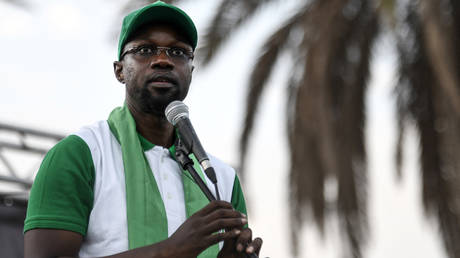Prison-State USA
by Vladimir Odintsov, New Eastern Outlook:

Washington is incessantly trying to inspire the whole world with this myth that the United States is the most democratic country on the planet, and that only Americans, the chosen nation, have the right to interfere in the internal affairs of other countries and establish their own preferred forms of governance there. Unfortunately however, this “American-style democracy” is the cause of growing resentment on many issues.
Let’s take a look at just one of the many reasons why people find this American exceptionalism so outrageous. There are currently more than 2.3 million people behind bars in the United States, which means the US holds more people in prison than any other country in the world. This is a quarter of all the world’s prisoners! When you consider the fact that there are more than 750 prisoners for every 100,000 US nationals, this makes the United States the world’s largest prison state. If we also add the number of Americans who have been released on probation and on parole to the overall sum of prisoners, it turns out that there is actually a total of 7.3 million people in the US prison system! That is, roughly one out of every forty people living in this “democratic country” is under some form of correctional supervision, or one out of every twenty adults!
American prisons are now overcrowded — the number of inmates is at about 200 percent of capacity. In October 2007 for example, there were 170,600 people incarcerated in California prisons with a capacity of 83,000. This has resulted in a large category of so-called “domestic inmates” living outside prisons (and this is about 5 million people), i.e. people living under house arrest, waiting for a bunk to be feed up in prison cell. Their “home confinement” is controlled by an electronic bracelet worn around the ankle, which keeps track of the prisoner’s movements, who have to keep within a 30-meter radius of the house. There is no fixed waiting time for prisoners doing time “at home”.
There are more prisoners than there are students in a number of federal states, and the “Champions” in this category include the states of California, Florida and Arizona. The American media have highlighted that there are now more prisons in the US than schools (there are over 5,000 prisons). More than 2.7 million children in the United States have a parent in prison, and the prison population has quadrupled nationwide since 1980.
The government spends a total of over $ 70 billion per year on the Federal Bureau of Prisons.
Every second American convict returns to prison within three years of their release. This is a very depressing figure. According to a 2017 report, having done time in a prison, which seeks to profit from inmate labor, increases the risk of incarceration by nearly 20 percent.
This situation with prisoners in the United States has long been more than just a law enforcement problem, there are inherent social and even racial problems. For example, although African Americans make up only 13% of the US population, they make up 40% of US prisoners, and 42% of those on death row. African Americans are sentenced to an average of one year more than white Americans for violent crimes.
The Raw Story has previously explicitly stated that the US prison system is clear proof of the existence of institutionalized racism in the country, and has reinforced this argument with a number of examples. To put this in context, there are now more black prisoners than there were black male slaves in the southern states before the start of the Civil War. An African-American man has a 32% chance of spending time in prison at some point in his life, while white men only have a 6% chance. Due to felony convictions, 2.2 million African Americans have had their right to vote taken away from them, i.e. 7.7% of this adult population has been deprived of suffrage, deprived of civil rights, and in three states (Florida, Kentucky and Virginia), one in five African Americans falls into this category.
But the US prison system is also a form of perpetuated “prison slavery” in this country. Believe it or not, this practice is actually legal, given that the Thirteenth Amendment to the US Constitution, which outlawed forced labor, contains a loophole: “Neither slavery nor involuntary servitude, except as a punishment for crime whereof the party shall have been duly convicted, shall exist within the United States, or any place subject to their jurisdiction.”
American researcher Vicky Peláez writes about the business of “prison slavery”, which usually occurs when state prisons hire out prisoners to private companies to perform labor. This type of business “partnership” does indeed have obvious benefits for private corporations: they pay “hired out” slaves the minimum legal wage set by the state where the labor is performed. And in some places they are even paid below the minimum wage. In the state of Colorado for example, prisoners are paid about $2 per hour, which is significantly lower than the minimum wage. “Prison slaves” are actively exploited by leading American corporations such as IBM, Boeing, Motorola, Microsoft, AT&T, Wireless, Texas Instrument, Dell, Compaq, Honeywell, Hewlett-Packard, Nortel, Lucent Technologies, 3Com, Intel, Northern Telecom, TWA, Nordstrom’s, Revlon, Macy’s, Pierre Cardin, Target Stores and many others. The popularity of this form of exploitation can be measured by the profits generated from inmate labor, which increased from $392 million to $1.031 billion between just 1980 and 1994.
At some point, the American authorities realized that the federal prison system could no longer cope with its overflowing number of prisoners, and turned to services offered by private firms. It turned out that private firms are able to turn a considerable profit by exploiting this labor force, which they are willing to do for the extra profits, just like what people used to do back in the bad old days of slavery. As a result, private prisons began appearing in the United States in the 1980s under President Ronald Reagan, and then state prisons continued to be privatized under presidents George Bush Sr. and Bill Clinton.
The idea of a cost-effective prison is nothing new — the state of Louisiana turned one of its prisons into a business back in 1844. This “industry” began to develop rapidly in the years that followed.
Private prisons are a multibillion-dollar industry, and it is growing. For instance, CoreCivic (formerly Corrections Corporation of America), the largest owner of for-profit prisons and immigration detention facilities in the United States, has seen its revenue increase by over 500 percent in less than 20 years, from about $280 million in 2000 to $1.77 billion in 2017. The three main private prison companies in the US — CoreCivic, the GEO Group and MTC — generate about $5 billion in revenue each year.
By 2018, the combined turnover of these three key business for-profit prisons along with several smaller prison corporations exceeded $7.4 billion. About 10 percent of the estimated 2.3 million people incarcerated in the United States are in private prisons. Private prisons receive a fixed sum from the state for each prisoner, regardless of the real incarceration costs. Thus, the prison business aims to cut costs by organizing a system and security regime that requires a minimal amount of work to be performed by guards. In one of CoreCivic’s ultra-modern prisons, there are only five employees guarding 750 prisoners.
It has come to light that there is a very high rate of profit in the US prison industry. This has not gone unnoticed, transnational corporations (TNCs) have reduced and even scrapped the incentive to transfer their production from the United States to less economically developed countries. The prison industry is one of the fastest growing industries, supported by investors on Wall Street.
Loading...



